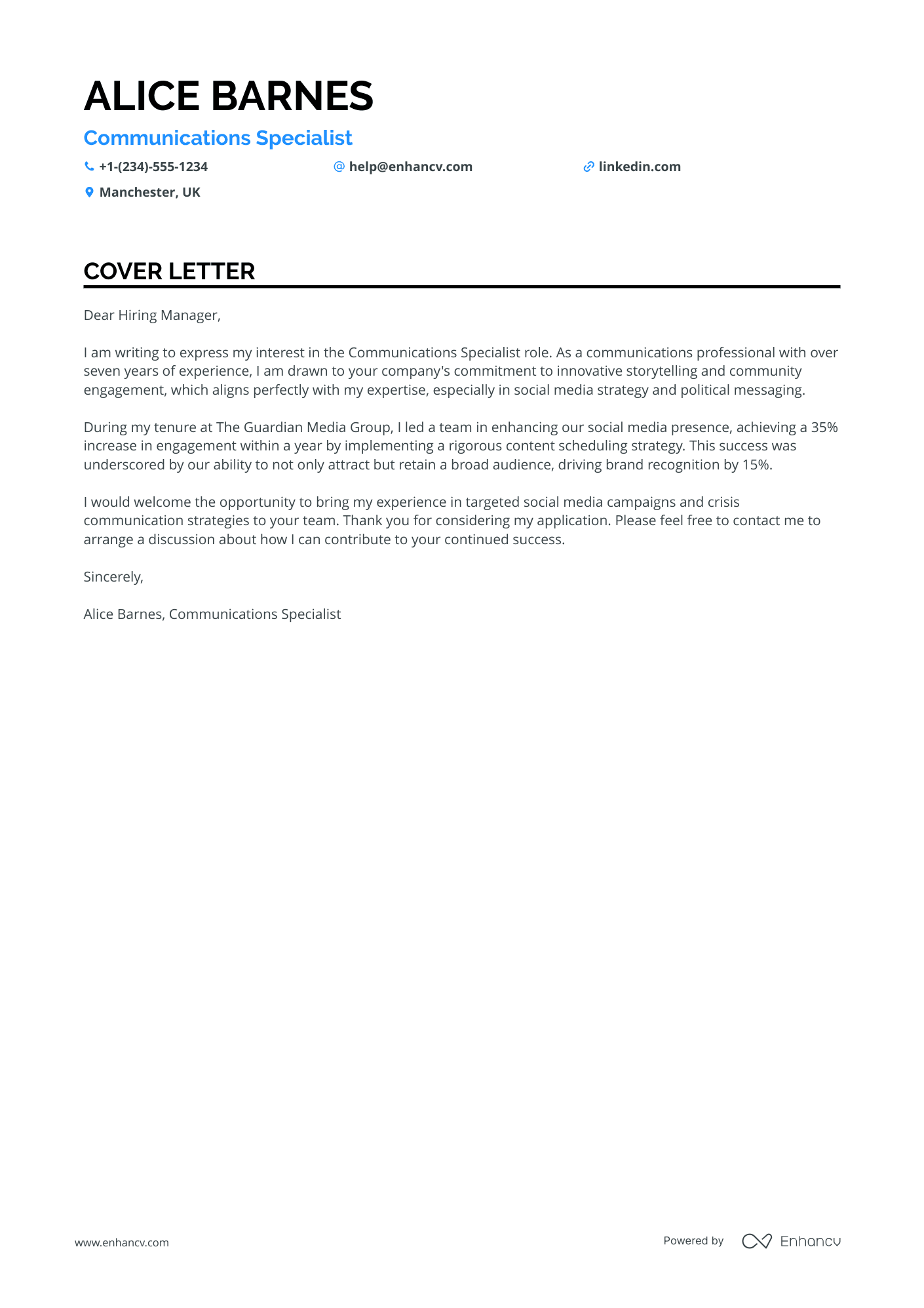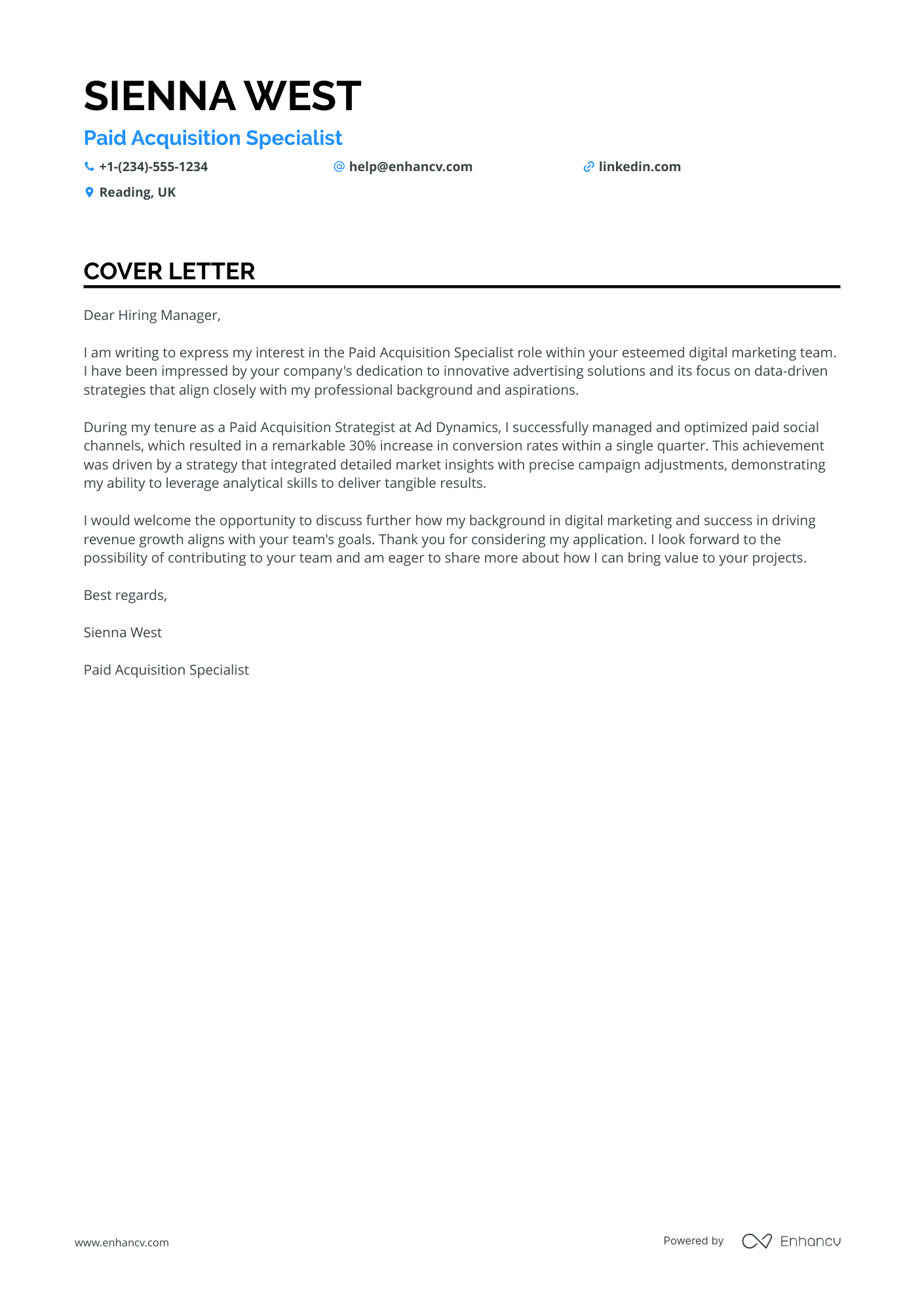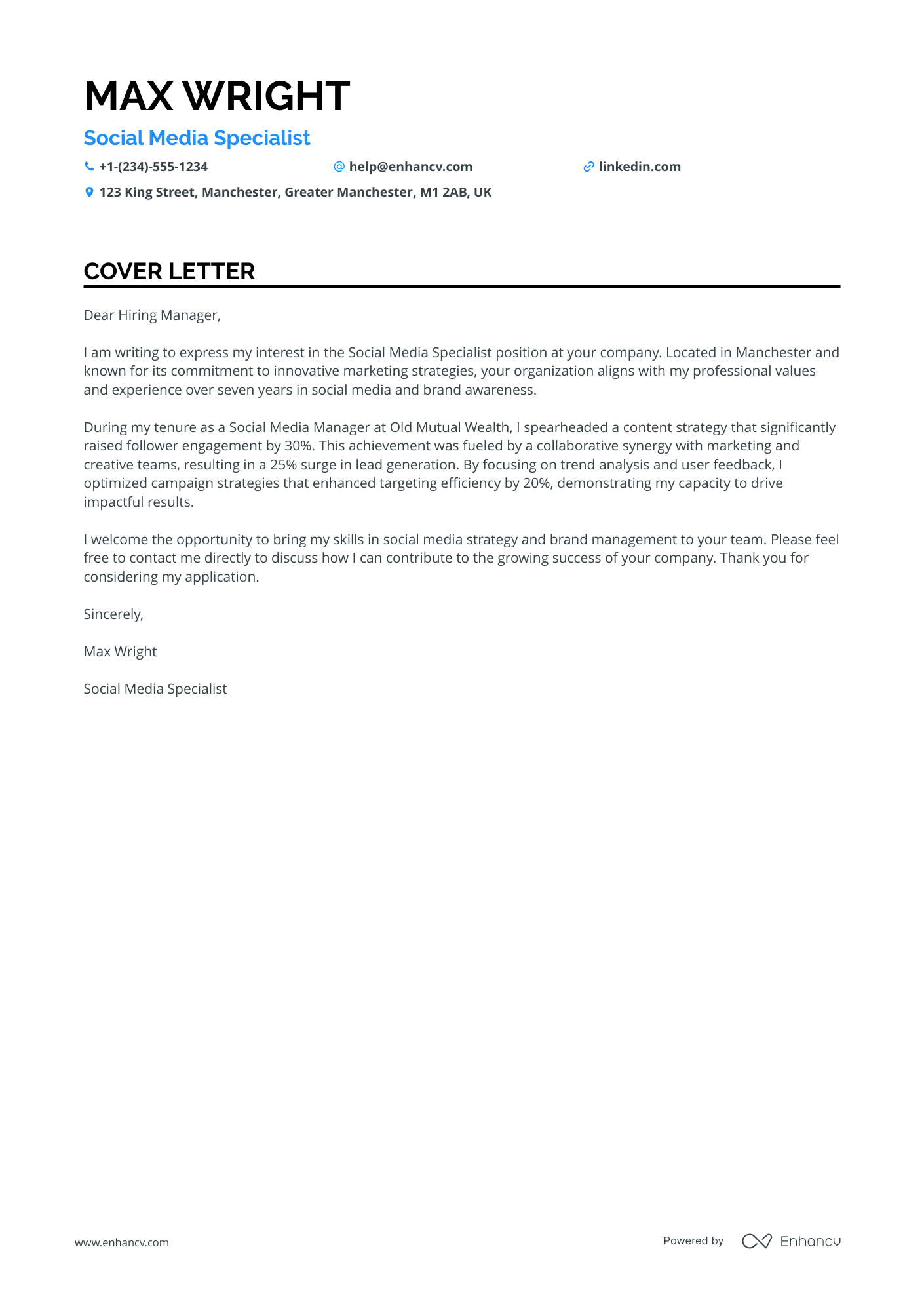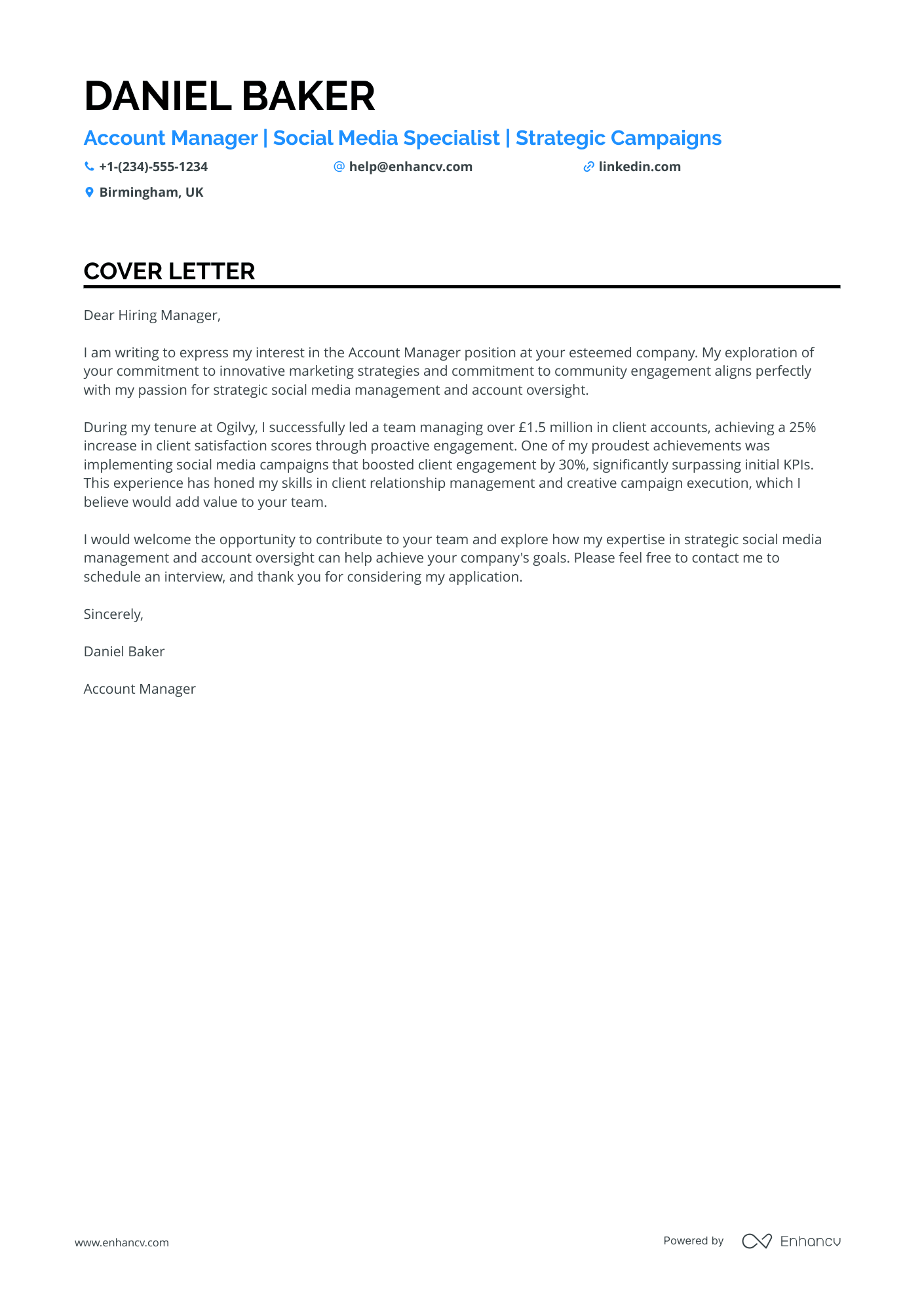Congratulations on completing your first cover letter. However, as you look back, you realise it’s simply a copy-paste of your CV.
Repeating your curriculum vitae is a common pitfall that many candidates encounter, making the cover letter redundant.
Your cover letter should provide fresh insights, adding more value to your application. It’s also the ideal space to address career gaps or major transitions that might not be covered in your CV.
In this guide, you’ll learn how to use your cover letter to demonstrate why you’re the best candidate for the role, while confidently addressing your career history and key achievements.
Cover letter examples for social media
By Experience
Social Media Director
- Effectively highlights a strong experience in social media and health communications, which are crucial for the role of Director in this field.
- The emphasis on a proven track record of increasing client engagement by 40% showcases results-oriented achievements that potential employers value.
- Incorporates certifications like the Advanced Social Media Strategy from HubSpot Academy, aligning with the need for advanced skills in social media strategy.
- Showcases a blend of technical and soft skills, such as client relationship management and crisis management, demonstrating a well-rounded professional profile.
Senior Social Media Strategist
- Specific Experience and Achievements: The cover letter effectively highlights Ivy Ward's practical experience and quantifiable achievements in social media strategy, particularly her success in increasing ROI by 40% and enhancing engagement for healthcare clients. This evidence-based approach strengthens the application by showcasing ability to deliver results.
- Emphasis on Strategic Skills: By emphasizing her strategic skills in data-driven insights and campaign management, the cover letter aligns her expertise with the needs of potential employers looking for a results-oriented social media strategist.
- Industry-Specific Passion and Knowledge: Demonstrating a passion for healthcare advocacy suggests an alignment with the industry, which is essential for marketing roles that require industry-specific knowledge and enthusiasm.
- Relevant Certifications and Courses: The inclusion of advanced courses like 'Advanced Social Media Strategy' and Google Analytics Certification directly connects Ivy's educational background to her role, underscoring her specialised skills and continuous learning in digital marketing.
Junior Social Media Analyst
- Highlighting Relevant Experience: The cover letter effectively underscores Harper Webb's 3 years of experience as a Social Media Analyst at major companies like Marks & Spencer and Sainsbury's, demonstrating a strong background in social media analytics and strategy.
- Emphasising Achievements: Specific achievements such as increasing social media engagement by 40% and optimising marketing strategies for a 25% increase in ROI are prominently featured, showcasing tangible contributions to business outcomes.
- Certifications and Courses: Harper highlights certifications such as "Social Media Marketing - Certified" from Coursera and advanced skills in data visualisation from a DataCamp course, underlining a commitment to continuous learning in specialised fields relevant to the role.
- Passion for Data Storytelling: The cover letter expresses a clear passion for data storytelling, which is relevant and beneficial for crafting compelling social media narratives and strategic content that engages audiences.
Entry-Level Social Media Specialist
- Quantifiable Achievements: Ella Bennett effectively uses quantifiable results in her cover letter to highlight her successes, such as increasing engagement by 45% and lead generation by 30% in her current role as a Social Media Manager. This demonstrates her impact clearly to potential employers.
- Relevant Certifications and Courses: The inclusion of certifications like the "Social Media Strategy Certification" from HubSpot Academy is significant as it establishes her expertise and commitment to continuous professional development in social media strategy, which is highly relevant to her field.
- Aligned Passions and Professional Experience: Ella's passions for environmental advocacy and creative writing are aligned with her past positions and accomplishments, providing a holistic view of her motivations and demonstrating her drive to integrate personal interests within her professional realm.
- Strategic Skill Set: The skills section covers a broad range of tools and capabilities essential for an E-Recruitment Specialist, with emphasis on social media marketing, content development, CRM tools, and analytics, ensuring she is seen as a well-rounded candidate ready to tackle various digital marketing challenges.
Head of Social Media
- Emphasised a strong track record in increasing media coverage and engagement, which is crucial for a role focused on media relations and public engagement.
- Highlighted achievements in crisis management, demonstrating the ability to handle high-pressure situations and protect the organisation's reputation.
- Showcased advanced education and relevant courses in Public Relations and Media Strategy, aligning with the role's need for strategic communication expertise.
- Included leadership experience in guiding teams towards achieving strategic goals, a valuable skill for managing media relations at a senior level.
Chief Social Media Officer
- Highlighting Experience and Achievements: The cover letter effectively emphasises Alice's extensive experience as a Communications Specialist, demonstrating proven success in enhancing engagement and social media strategy, a critical aspect for the role.
- Emphasising Relevant Skills: Skills such as Crisis Communication, Political Messaging, and Stakeholder Engagement are prominently mentioned, showcasing capabilities highly relevant to the role's demands.
- Showcasing Advanced Certifications and Courses: Listing completed courses like Advanced Social Media Strategy and Digital Communication and Public Relations highlights Alice's commitment to professional development and expertise in specialised areas.
- Incorporating Measurable Success: The cover letter uses quantifiable results (e.g. increasing followers by 35%) which provide concrete evidence of Alice's effectiveness, making her claims more compelling and credible.
By Role
Social Media Manager
- Highlighting certifications like the Facebook Blueprint Certification and Google Ads Certification can emphasise expertise in platform-specific social media marketing, which is crucial for a Social Media Manager role.
- Emphasising significant achievements such as boosting social media engagement by 200% and increasing client audience reach by 250% can showcase the candidate's ability to generate tangible results.
- Mentioning collaboration and strategic planning skills, as demonstrated through the management of social media plans and teamwork, highlights the candidate’s capability to align social media activities with broader business goals.
- Focusing on analytical skills by referencing KPI analysis and Google Analytics helps underline the candidate’s proficiency in data-driven decision-making, a crucial aspect for continuous improvement in a digital marketing role.
Social Media Strategist
- Emphasise Relevant Expertise: Highlighting experience in LinkedIn and Meta Ads, which directly aligns with the role of a Paid Acquisition Specialist.
- Showcase Quantifiable Achievements: Mention of percentage improvements in conversion rates, engagement, and revenue growth to demonstrate the impact of strategic interventions.
- Highlight Strategic Collaborations: Describing partnerships with sales and product teams showcases the ability to integrate marketing efforts across different company divisions for enhanced results.
- Underscore Continuous Learning: Listing relevant courses and certifications indicates commitment to staying current in the field, a valuable trait for digital marketing roles.
Social Media Analyst
- Emphasise the candidate's success in influencer campaigns and community management, as these aspects are crucial for a Social Media Analyst role focused on increasing engagement and brand awareness.
- Highlight the specific tools and platforms Mia is proficient in, such as Instagram, Facebook, Twitter, TikTok, Pinterest, and LinkedIn, showcasing readiness to tackle diverse social media environments.
- Mention relevant education and coursework that strengthen credentials, such as a Master of Science in Marketing and courses like "Advanced Social Media Strategy" and "Digital Marketing Analytics."
- Showcase achievements in driving significant increases in engagement and reach, displaying a tangible impact on clients' digital strategies and overall success in social media analysis.
Social Media Specialist
- Highlighting Relevant Experience: The cover letter effectively showcases Max's extensive experience in social media management roles, emphasising leadership in strategy development and community engagement, essential for a Social Media Specialist.
- Quantifiable Achievements: It includes specific metrics such as "30% increase in follower engagement" and "40% improvement in ROI," providing concrete evidence of Max's ability to drive success in social media initiatives.
- Mention of Specific Tools and Techniques: The reference to tools like Hootsuite and Sociabble in addition to KPI measurement illustrates Max's proficiency with industry-standard tools, which is crucial for executing successful social media campaigns.
- Certifications in Social Media Marketing: The mention of the HubSpot Academy certification demonstrates a formal commitment to continuous learning and expertise in developing effective social media strategies, adding credibility to Max's skill set in digital marketing.
Social Media Coordinator
- Emphasise your success in managing multi-channel campaigns, showcasing your ability to increase engagement by leveraging your extensive experience in live events.
- Highlight your skills in content creation and storytelling, as seen from your track record of increasing social media engagement by 30%, to showcase creative innovation and impact.
- Mention your effective collaboration with cross-functional teams including marketing and PR, which improved brand storytelling and contributed to enhanced event engagement.
- Include specific achievements like the award-winning campaign, which led to a 50% increase in engagement metrics, as evidence of your capability to deliver exceptional outcomes.
Social Media Consultant
- Highlighting the candidate's 8 years of experience in digital marketing and specific achievements, such as leading a social strategy that increased brand engagement by 30%, establishes credibility and showcases a track record of success, which is crucial for a Social Campaign Consultant role.
- Mentioning proficiency in audience analysis, campaign management, and the use of social listening tools demonstrates the analytical and strategic skills necessary for creating effective digital campaigns and optimising social media strategies.
- Detailing experience with influencer marketing, including initiatives with nano and micro influencers leading to a 30% growth in brand awareness, emphasises the candidate’s familiarity with current marketing trends and ability to expand brand reach, a valuable skill for digital growth.
- Including achievements, such as mentoring junior team members to enhance morale and productivity, underlines strong leadership and team-building abilities, which are beneficial in roles requiring collaboration and guidance of others.
Social Media Content Creator
- Highlighting Measurable Results: The cover letter includes specific data points that quantify Scarlett's success in previous roles, such as a 25% enhancement in user engagement and a 200% increase in product awareness. Using numbers provides clear evidence of achievements.
- Industry-Relevant Skills and Tools: By mentioning proficiency in analytics tools, SEO strategy, and social media marketing, the cover letter aligns Scarlett's skills with those relevant to digital marketing and social media roles.
- Demonstrating Leadership and Collaboration: Scarlett's experience in leading teams and collaborating with cross-functional partners is highlighted, showcasing her ability to work effectively in different group settings to achieve shared goals.
- Consistency with Career Progression: The cover letter illustrates a clear career trajectory in social media and digital marketing, substantiated by progressive roles spanning Digital Marketing Specialist to Social Media Manager, enhancing credibility and commitment to the field.
Social Media Sales Representative
- Highlight specific achievements in lead generation and revenue contribution, such as increasing client acquisition by 25% and achieving a 40% sales target surplus, to demonstrate proven success and value to potential employers.
- Emphasise certifications and courses that align with the job role like the "NVIDIA Deep Learning Institute Certificate" which specialises in GPU and AI technologies, underscoring specialised knowledge relevant to the industry.
- Showcase unique skills and accomplishments that set you apart, such as developing tailored cloud solutions and innovative processes that enhance market penetration and lead conversion.
- Incorporate past experience and collaborative efforts that resulted in significant contracts, like securing £500,000 contracts with Account Executives, highlighting ability in team collaborations and the capacity to close large deals.
Social Media Customer Service Representative
- Emphasising strategic community outreach: Highlighting how Oscar Evans implemented targeted community outreach strategies, which increased donor contributions by 25% in a year. This showcases his ability to effectively drive community engagement and fundraising efforts.
- Showcasing event management skills: Detailing the successful organisation of major fundraising events, especially those that resulted in significant increases in donations, demonstrates his competency in managing events that are critical for donor relations and community engagement.
- Highlighting certifications specific to fundraising: Mentioning the completion of a course on Advanced Fundraising Techniques from the Institute of Fundraising underscores his commitment to professional development in fundraising and directly aligns with the role's requirements.
- Demonstrating recognition through awards: Receiving the Exceptional Donor Growth Award and Innovator of the Year shows external validation of Oscar Evans's capabilities in donor expansion and creative fundraising, which are valuable assets in customer engagement and advocacy roles.
Social Media Graphic Designer
- Emphasises practical successes by detailing quantifiable impacts made in prior positions, such as a 30% increase in engagement and a 25% boost in productivity.
- Highlights specialised skills and extensive experience with Adobe Creative Suite, essential for a career in graphic design and brand strategy.
- Mentions leadership and collaborative abilities, which are crucial for guiding creative teams and implementing effective brand initiatives.
- References continued professional development through courses like "Creative Leadership and Brand Strategy," demonstrating a commitment to staying current in the field.
Social Media Influencer
- Highlighting Achievements: The cover letter effectively showcases Sophia's accomplishments, such as achieving a 25% increase in student engagement through social media, demonstrating her ability to deliver tangible results.
- Specific Skill Set: Sophia emphasises her expertise in videography, analytics, and social media management, which are critical skills relevant to content creation and social media marketing roles.
- Relevant Certifications: Mentioning the Social Media Marketing Certification from HubSpot aligns with her role as a Digital Content Specialist, adding credibility to her strategic and creative campaign development abilities.
- Educational Background: The inclusion of her Master of Science in Marketing highlights a strong educational foundation that supports her professional experience and skills in digital marketing.
Social Media Account Manager
- Highlighting a proven track record in successful social media campaigns, including a significant 30% engagement increase for a leading brand, is crucial for demonstrating the candidate's effectiveness in this role.
- Emphasising leadership skills through the successful management of substantial accounts and cross-functional teams enhances the candidate's suitability for an Account Manager position.
- Experience in developing strategic plans and aligning client objectives with agency capabilities showcases the ability to deliver tailored solutions, a key component for success in the role.
- Relevant certifications such as the Advanced Social Media Strategy course from HubSpot Academy and PMP underscore the candidate's commitment to maintaining a high level of professional development and expertise.
Social Media cover letter example
Florence Knight
Manchester, UK
+44 1234 567890
help@enhancv.com
- Company Alignment: The cover letter effectively demonstrates alignment with the company's values and recent initiatives, such as the focus on social responsibility. This shows a deep understanding and interest in the company’s mission.
- Relevant Achievements: Highlighting a specific accomplishment, like the interactive marketing campaign at CreativeX that increased user engagement by 40%, provides concrete evidence of the candidate's ability to deliver results in a related role.
- Collaboration and Analytical Skills: Mentioning collaboration with a team and the use of performance metrics showcases the candidate's ability to work well with others and make data-driven decisions, which are crucial skills for a Social Media Specialist.
- Invitation for Further Discussion: Expressing a willingness to discuss further highlights the candidate’s genuine interest in the role and eagerness to contribute, making it more inviting for the employer to reach out.
Importance of cover letters in the United Kingdom
Cover letters provide recruiters with the opportunity to learn more about your career aspirations, hinting at how you’d integrate within the organisation over the long term.
Here are three additional reasons why cover letters are important:
- Making an excellent first impression (and a formal introduction): Your cover letter is often the employer’s first introduction to you, showcasing your personality, communication skills, and motivation for the role.
- Complementing your career history: While your CV lists qualifications and experience, a cover letter provides the context, explaining how your background fits the role.
- Demonstrates your genuine interest: A well-crafted cover letter reflects the effort you’ve put into researching the company and role as well as your attention to detail.
What UK employers expect from a cover letter
Your UK employers will appreciate your application if you've taken the effort to tailor your cover letter to their job requirements.
Here’s how to ensure yours ticks all the right boxes:
- Research the company thoroughly: It's not enough to have only read the job advert. Look into the company's history, products, services, and recent achievements to demonstrate your genuine interest and knowledge.
- Connect with the company’s values: Every company has core principles that shape its culture and operations. Identify these values and use your cover letter to show how they align with your professional conduct and ethics.
- Emphasise your relevant skills: Highlight specific skills that match the job description and are most in demand. Use examples from your previous experience to support your claims and set yourself apart from other candidates.
How to format a social media cover letter
Have you ever wondered about the formatting and structure of your cover letter?
Read on to discover some guidance from industry-leading professionals:
- Within the header, include your address and contact details, the employer's name and address, and the date, followed up by a personalised salutation.
- The body should should consist of an opening paragraph, middle paragraphs expanding on your unique experience and skills, and a closing paragraph.
- End with a formal sign-off and your signature.
- Choose modern fonts such as Volkhov, Chivo, or Bitter instead of the more traditional Arial or Times New Roman.
- All of ENhancv's templates maintain single-spacing with approximately 1-inch (2.5 cm) margins on all sides to ensure a neat presentation.
- Always send your cover letter as a PDF to keep the formatting intact and prevent any edits once submitted.
Your CV and cover letter maintain consistent formatting. Use the same fonts, margins, and style to create a professional and cohesive look for your application.
Finally, remember that Applicant Tracking Systems (the software some companies use to align job keywords to your experience, also known as ATS) do not read cover letters–it's intended solely for recruiters. Make it stand out by highlighting your achievements and relevant skills for the role.
How to write your social media cover letter salutation
In a world of AI and instant prompts, taking the extra time to personalise your cover letter truly makes a difference.
Address the hiring manager directly with a customised greeting (e.g., 'Dear Mr Bond', 'Dear Ms Penny').
You can often find their name on LinkedIn (under the job listing or by searching) or in the ‘About’ or ‘Meet the Team’ section of the company's website. If in doubt, you can also contact the reception for assistance.
If you can't find the name, rather than using 'Dear Sir or Madam', opt for something more personal, such as 'Dear [Company Name] Hiring Manager'.
How to write your social media cover letter intro
It's never a bad time to show enthusiasm about the role, company, or team in your cover letter introduction.
Begin by sharing one or two aspects that genuinely excite you about the position—whether it's the company culture, specific responsibilities, or the team's past achievements.
Your enthusiasm demonstrates that you'll bring a strong work ethic, are eager to contribute, and are motivated to succeed.
How to write your social media cover letter body
Your cover letter body is the most spacious and vital part of this document—it highlights your true value and the impact you can bring as a candidate.
Remember, your cover letter serves a different purpose to your CV. Here, you need to show your skills in context by telling the story of one significant achievement, hinting at how you’ll help your future employer achieve their goals.
So, when writing your cover letter body:
- Use concrete achievements to demonstrate your personality and impact.
- Support your achievements with quantifiable data and metrics.
- Tell the story of a successful project you’ve worked on and explain how you contributed to the outcome.
- Highlight both hard and soft skills to make your story more engaging.
- Focus on skills that are most relevant to the role and align with the company’s needs.
How to write a closing paragraph
There’s a wrong and a right way to close your cover letter. Here’s how.
The wrong way is to end with a signature or a formal 'Thank you in advance.'
The right way is to either promise how you’d make a positive impact on the company or ask when you can expect a response. This will highlight you as a forward-thinking candidate who’s enthusiastic about securing the role.
Conclusion
Crafting an engaging cover letter can significantly enhance the effectiveness of your job application. Always personalise your letter by addressing the hiring manager directly and linking your qualifications to the role's requirements.
Highlight relevant achievements that set you apart and demonstrate your enthusiasm for the company. Maintain a professional format that complements your CV, creating a cohesive and polished application.








































